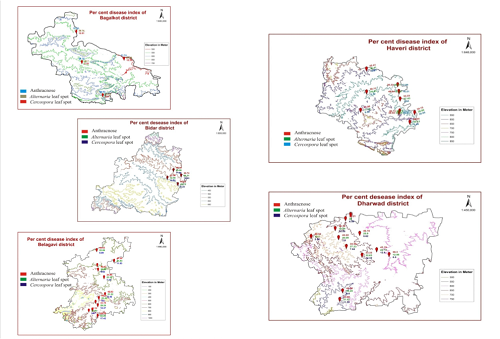Hemibiotrophic foliar Fungal Diseases and their Dynamism in GPS system in Soybean growing areas of Karnataka
Research Article | Published: 11 January, 2019
First Page: 119
Last Page: 122
Views: 3755
Keywords: Hemibiotrophic, Foliar Fungal, GPS, Northern Karnataka
Abstract
A survey was conducted to determine the influence of elevation, longitude and latitude against major hemibiotrophic foliar fungal diseases of soybean during kharif 2016 in soybean growing areas of northern Karnataka. Data revealed that the latitude between 14°N to 15°N recorded maximum disease severity of anthracnose (40.38 PDI), Alternaria leaf spot (28.46 PDI) and Cercospora leaf spot (11.98 PDI). As the latitude increased from 15°N to 17°N disease severity recorded at declining trend. In relation to longitude, maximum severity was observed between 74°E to 75°E. Severity showed an increasing trend from 400 m of elevation to 700 m. The maximum severity of 42.00 PDI was recorded in anthracnose, 28.45 PDI in Alternaria leaf spot and 13.64 PDI in Cercospora leaf spot at an elevation of > 700 m from mean sea level. Higher incidence and severity of foliar diseases were recorded at more than 700 m MSL, however no much difference was observed with respect to latitude and longitude.

References
- Cerkauskas RF (1988) Latent colonization by Colletotrichum spp.: Epidemiology considerations and implications for mycoherbicides. Can J Plant Path 10: 297-810.
- Chellemi DO, Britton KO and Swank WT (1992) Influence of site factors on dogwood anthracnose in the Nantahala Mountain range of western North Carolina. Plant Dis 76: 915-918.
- Hara KB (1930) Pathologia Agriculturalis Plantarum. Tokyo. Pp 950.
- Kamthane DC and Rakh RR (2013)Studies on per cent incidence and severity index of Alternaria blight of soybean of Parbhani district. Asian J. Microbiol Biotech Env Sci 15(3): 615-619.
- Keissler (1912) Type species Alternaria alternata (Fries) Keissler. Beih Bot Cent 29: 434.
- Kleczewski N (2014) Frog Eye Leaf Spot on soybean. Ph. D. Thesis, Univ Deiaware. Pp 20.
- Mayee CD and Datar VV (1986) Phytopathometry, Marathwada Agricultural University, Parbhani (India). Pp 146.
- Mittal RK (2001) Yield losses by frog eye leaf spot and anthracnose diseases in soybean under different sowing dates in the north western hills of India. Indian Phytopath 54 (1): 32-34.
- Sinclair JB and Backman PA (1989) Compendium of soybean diseases. Amer Phytopath Soc St., Paul. Minnesota, USA. Pp 22.
- Vyas SC, Vyas S and Shroff VN (1997) Diseases of soybean. SOPA Dig 7: 15-33.
- Wheeler BEJ (1969) An Introduction to Plant Diseases. Jhon Willey Sons Ltd., London. Pp 301.
Author Information
Department of Plant Pathology, AICRP on Soybean, University of Agricultural Sciences, Dharwad- 580 005, Karnataka, India